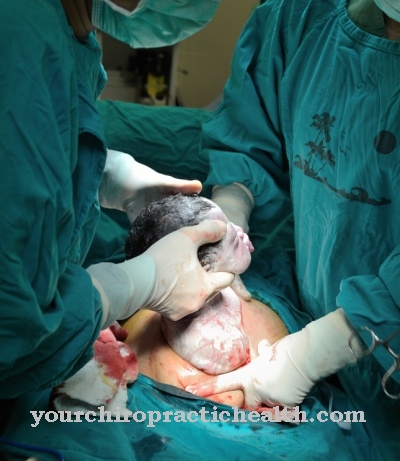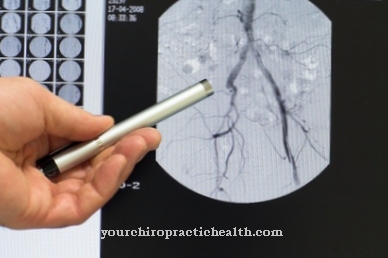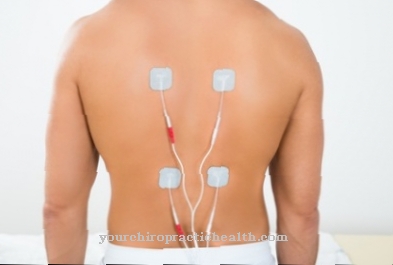Under the Screw fixation one understands the screwing and bridging of broken bones (fractures) with foreign material in the form of screws. The screws used for this are made of surgical steel, titanium or similar materials.
What is screw fixation?

This form of osteosynthesis is a frequently used method for the internal anatomical refixation of fractures or fracture fragments (fragments). The advantage of this method is that usually only a minimally invasive surgical procedure has to be carried out. In addition, with displaced fractures (e.g. ankle joint) there is only a slight loss of the joint surface.
The aim of the screw connection is to fix the fractures or fragments until they have healed. Axis and joint misalignments that have arisen are corrected during refixation. The advantage over non-surgical (conservative) treatment methods is that the anatomy can be restored precisely and in a targeted manner. The fractured area can be practiced quickly, moved and fully loaded depending on the symptoms. In this way, movement restrictions and muscle atrophy can be prevented. Movement reduces the risk of thrombosis.
Function, effect & goals
Screw fixation is mainly used in surgery and orthopedics when conservative treatment is not possible. This is the case if, for example, is an open fracture. The procedure is performed under anesthesia. This can be plexus anesthesia, spinal anesthesia or general anesthesia. The duration of such an operation depends on the degree of injury. The stay in the hospital then amounts to a few days, whereby the later material removal can also be carried out on an outpatient basis.
The treatment of an open fracture with screw fixation significantly reduces the risk of subsequent bone or soft tissue inflammation. For upper and lower leg fractures, conservative treatment is possible, but osteosynthesis makes more sense. Thanks to the internal stabilization, the affected lower extremity is immediately stable after the operation. This means that the patient can move and exercise the limb freely. After a few days of exercising, the leg can be fully loaded, depending on the state of pain.
If there is a multiple trauma, multiple fracture or comminuted fracture, the fracture fragments are repositioned and fixed. In principle, fractures with displaced fracture fragments are treated with screw osteosynthesis. The aim here is always to reposition and fix the displaced fragments and to restore any joint functions in their anatomical axis.
Screw osteosynthesis is not only used for trauma-related fractures. Other areas of application include the orthopedics. Targeted severed bones are fixed by this procedure for alignment in case of axial misalignments (e.g. knock knees or bow legs).
Osteosynthesis is also used for arthrodesis (joint stiffening), general instability or instability after tumor removal. But even with soft tissue injuries, screw fixation is sometimes preferred to plate fixation. The operational process is as follows: As soon as the surgeon has gained access to the fractured area, the fracture fragments are aligned with one another in the correct position. When it comes to the actual fixation of the fracture, a distinction is made between cortical screws and cancellous screws. Both are so-called lag screws, these are supposed to pull the break point together.
The difference is that the cancellous bone screw has a short shaft and is screwed in the epiphyseal area. The operating doctor drills out the cortex of the bone so that a cancellous screw fits into the hole. A smaller hole is drilled in the opposite fragment, into which a thread for the screw is cut with a special instrument. Now the screw is screwed into the holes and the bone piece with the thread is drawn against the bone piece with the simple hole. Tightening the screw securely connects the fracture fragments.
The cortical screw, on the other hand, is screwed in the diaphyseal area. Compared to the cancellous bone screw, this has a long shaft and a short thread at the lower end. Here, too, the surgeon drills a hole in the bone into which the screw goes. This is now screwed in so that the thread lies behind the break line. As with the cancellous bone screw, the cortical screw pulls both fracture fragments together and fixes them in this way.
Risks, side effects & dangers
Screw fixation is always associated with a surgical procedure. This increases the risk of infection, because a closed fracture becomes an open fracture and germs can penetrate and the risk of infection increases. In addition, it can lead to functional restrictions, pain, wound healing disorders, pseudarthroses, instability and arthrosis.
Possible serious complications can be the loosening or breaking of the implant due to material failure. This can cause the fracture fragments to slip and result in malpositions or shortened extremities. In order to prevent this, regular follow-up should be carried out by the treating surgeon or orthopedic surgeon, with control by means of imaging procedures. Secondary bleeding, scarring with adhesions can, as with any surgical procedure, also occur here. General risks of anesthesia, especially in elderly patients with poor general health, such as swallowing difficulties, cardiovascular problems, breathing disorders, etc. should always be taken into account.
In addition, another surgical procedure must be carried out to remove the material. Often the material is not removed in older patients because the bone material is usually no longer as firm as it was before. Otherwise a so-called refracture can occur. In children, however, the material must be removed shortly after the fracture has healed, as the bones are still growing.

























.jpg)

.jpg)
